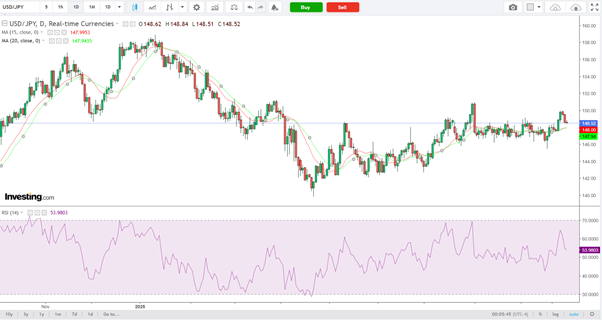UiPath shares surge on NVIDIA, OpenAI partnerships
USD/JPY closed at 148.52, with an intraday high of 148.84 and a low of 148.51. The pair has been consolidating after a modest rebound from earlier lows, but momentum is showing signs of fatigue.
Key Technical Observations
- Moving Averages Neutralizing: The 15-day (147.99) and 20-day moving averages (147.94) are almost overlapping, signalling a lack of clear direction. This flattening slope suggests consolidation.
- Trend Structure: After a strong decline from the 156.00 peak, the pair has been range-bound between 146.00 – 150.00, struggling to break convincingly higher.
- RSI Mid-Zone: The RSI reads 53.98, which is neutral. This highlights the absence of strong momentum and indicates sideways drift, with neither bulls nor bears in full control.
- Candlestick Behaviour: Recent price action shows small-bodied candles, reflecting indecision and lack of conviction for a breakout.
Macro & Market Context
- BoJ Policy Outlook: The Bank of Japan remains cautious on tightening, but any shift in yield-curve control or interest rates could pressure the pair lower.
- US Data Sensitivity: USD performance continues to hinge on U.S. inflation and labour market data, feeding into Fed expectations.
- Risk Sentiment: Broad risk-on moves tend to weaken JPY (safe-haven outflows), while risk-off phases support JPY.
Key Levels to Watch
- Immediate Resistance: 149.50 – minor cap inside the current range.
- Next Resistance: 151.50 – last rejection point.
- Immediate Support: 147.00 – range floor.
- Deeper Support: 145.50 – if the range breaks to the downside.
Bias: Neutral-to-Slightly Bearish
Momentum indicators and price compression point toward continued sideways action within the 147.00–149.50 band. Failure to break higher leaves the pair vulnerable to gradual drift lower, especially if DXY weakens further.
The pair is in range-trading mode. Traders can look for opportunities to sell near 149.50 resistance or buy dips into 147.00, with tight stops to avoid whipsaw. Breakouts beyond these levels are likely to bring volatility and establish new directional momentum.

